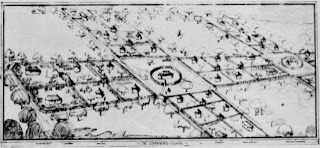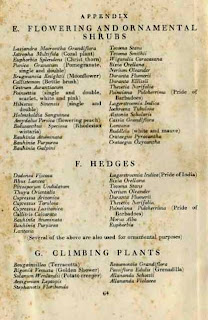 |
| The prince, the governor and the architect |
"To plan a city on virgin land, to build the nucleus of a capital for a country, is essentially an act of faith, a looking forward to the increase that the years will bring."
So begins this short account of Professor Adshead's plan of the city, and the matter is very much in this vein, about how to cater for the expansion of the city in future, and where to site various facilities so as to benefit residents most. There is a short history of African exploration and we hear the story of how Livingstone's initials 'can still be faintly seen' on a tree on an island on the brink of the falls, carved on the day he reached the falls in 1855. I wonder if there are earlier mentions of this story, which lately seems to be regarded as apocryphal. We are told that the inscription on the tree in Chitambo's village where Livingstone was buried reads LIVINGSTONE - MAY 4 - 1873 - SOUZA - MNIASERE - YCHOPERE. The last three the unnamed author says are 'probably names'.
 |
| An early prospector party |
Lusaka, he says, is intended to be both a commercial and administrative capital, succeeding Fort Jameson as capital of N.E. Rhodesia and Kalomo as capital of the North West (up to 1907), and Livingstone, which had become capital in 1911.
 |
| The first secretariat building in Kalomo, 1899 |
 |
| Government House, designed by Walcot |
 |
| The original Lusaka airport, in the town centre, designed by Norman, Muntz & Dawbarn of Heston. 'If someone arrives at the wrong aeroplane there is another path' |
 |
| Gymkhana club ('Lusaka Club') designed by Flutter |
The area covered by Lusaka is unusually large for its time and population, allowing for growth, and separates civic activity from residential and commercial - 'no untidy mingling'. The chequer-board design of many modern cities is rejected in favour of the crescent and circus. Of course, there are also separate accommodation and trade areas for Africans and Europeans. The shopping area is not yet built, but planned on the site of an old golf course.
The Ridgeway is to be the main artery, only one mile of which has been constructed. The new streets will be 120 feet wide -- not, as some might imagine, to allow an ox cart to turn around, but to allow for cars to park. A site for the cathedral has been set aside at a place where it would 'probably appear as the most important building'. Houses are also being planned to deal with the extremes of temperature as well as mosquitoes, with 'glassed in sleeping porches'. Even built-in garages are provided in officials' houses, one of which is known as the Yodel house, because it is based on one in the Austrian Tyrol. The
 |
| The Secretariat (?) |
 |
| Garden front Government House |
The African population is catered for by two classes of accommodation: personal servants and others, in separate compounds. 'Quarters are only provided for one unmarried boy on each plot... Thus not only is the residential area freed from picannins and other manifestations of domestic untidiness and noise, but an opportunity is afforded to provide these families with a life of their own'. The 'boys' are considered to have reached a higher standard of culture and civic behaviour and will prefer to associate with their fellows. The layout of the compounds hopes to preserve the best features of the African village, with family accommodation in clusters of four units, 'looking into itself and divided by an appreciable space from its neighbour.... The modern village housewife... makes her husband build her a separate kitchen a few yards away', but they can't quite manage that, so subdivided communal kitchens were a compromise. We are told that some women have already made formal paths from their huts to their kitchens.
 |
| The governor's village |
Any visitor to Lusaka will have noticed the trees, and much thought was given to them at this time. Adshead had imagined banana trees and palms, but at this height they were not easy to grow. The majority of roads were lined with double rows of trees, some jacaranda, African Flame Tree, or the yellow flowered Markhamia, some mangoes, or wild fig or mahogany, Pride of India, cypress, yellow tecoma or oleander and so the list goes on (see lower down). Even the moringa 'which is said to provide horse-radish from its roots, spinach from its leaves and a flavouring for curries from its pods' is there. And whilst they cannot see the benefits of all this in 1935, we can now enjoy their efforts in many parts of the capital.
The King's birthday in 1935 was chosen as the date of completion. The project, which had been budgeted at £435,000, came in at just £400,000, ahead of schedule.
 |
| The adopted plan |
 |
| The original plan |

 Here are those plants and trees in full, from the appendix, some indigenous, some imported. I must admit I can't ever recall seeing a sausage tree in Lusaka. I wonder how many of these can still be found. You'll notice also that lantana is on the list, which is now considered a weed by most.
Here are those plants and trees in full, from the appendix, some indigenous, some imported. I must admit I can't ever recall seeing a sausage tree in Lusaka. I wonder how many of these can still be found. You'll notice also that lantana is on the list, which is now considered a weed by most.Names in this book:
Most of these are brief mentions. There are a couple of nice tales.Adshead, Professor
Baker, Sir Herbert
Chaka (Zulu)
Chitambo (Chief)
Chitanda
Chitimukulu (Awemba)
Coillard, Francois (Revd)
Codrington, Robert
Coryndon
Dawbarn, Graham
Flutter, Mr A. T. (A.R.I.B.A.)
Gamitto, Captain
Heal, Messrs of London
Hoogterp, Mr J.A. (F.R.I.B.A.) architect
Johnston, Harry
Kazembe (Chief)
de Lacerda e Almeida, Francisco Jose Maria
Lewanika
Livingstone, David
Lobengula
Mackinnon
Maxwell, Sir James
Moffat, Dr
Monteiro, Major
Mpeseni (Ngoni)
van Oost (Pere)
Pauling, George
Rhodes, Cecil
Sebotoane (Chief)
Sharpe, Alfred
Thomson, Joseph
Uzwangendaba (Ngoni leader)
Walcot, Mr (F.R.I.B.A.)
Williams, Sir Robert
Young
References
Lusaka 1935, Jonathan Cape, private circulation, 1935North of the Zambezi, Anthony, L.F. G., Northern Rhodesia Information Dept, 1953







